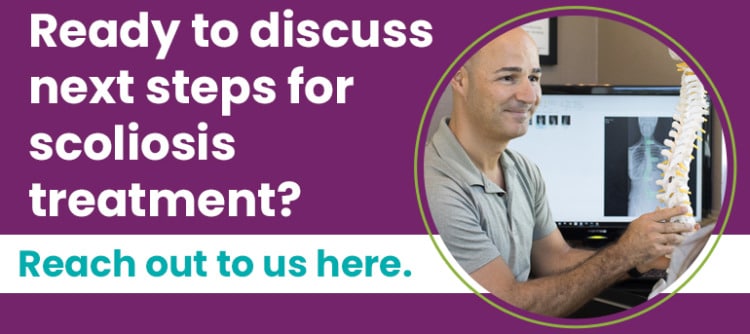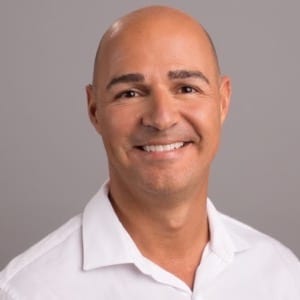Idiopathic Scoliosis: Causes, Symptoms, and Treatments
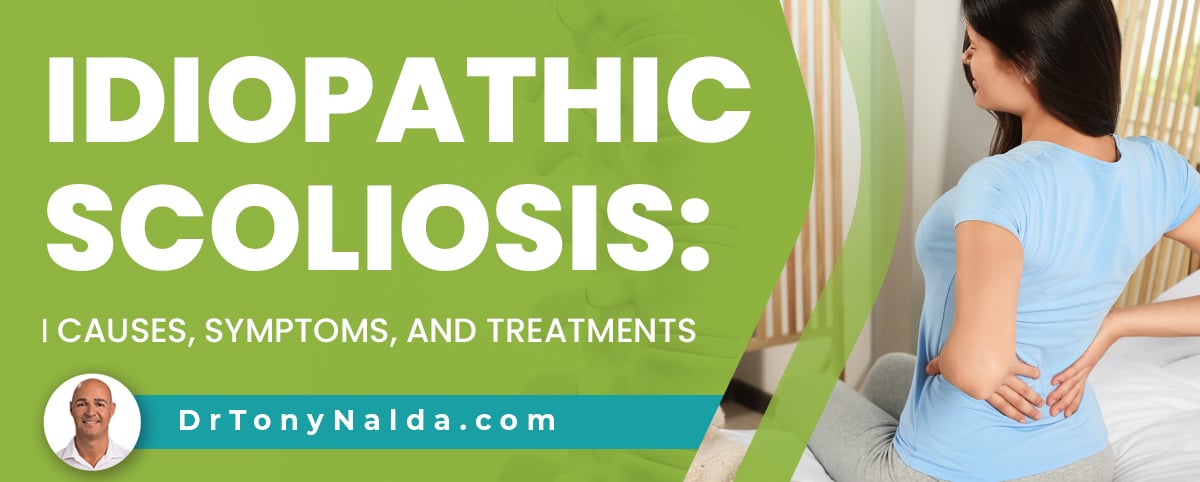
Scoliosis needs to be treated proactively, and treatment plans need to be fully customized to address key patient/condition variables. Although we don't know what causes idiopathic scoliosis to develop initially, we know how to treat it effectively.
Idiopathic scoliosis is the most common type of scoliosis to affect all ages. Idiopathic means cause unknown, and as a progressive condition, its nature is to get worse over time. Progressive scoliosis is triggered by growth, which is why childhood scoliosis should always be taken seriously.
Scoliosis is a complex structural spinal condition that ranges widely in severity, and there are also different types of scoliosis.
Table of Contents
The Four Main Types of Scoliosis
The type of scoliosis is determined by its underlying cause, and the most common type overall is idiopathic scoliosis.
Idiopathic means cause unknown, and this isn't the same as saying there is a complete absence of a cause; instead, idiopathic scoliosis is thought to be multifactorial (caused by a number of variables that can vary from person to person).
Idiopathic scoliosis is the most common type of scoliosis to affect all ages, but it is most commonly diagnosed in children.
The most prevalent type of scoliosis overall is adolescent idiopathic scoliosis diagnosed between 10 years old and reaching skeletal maturity.
Once skeletal maturity has been reached, growth has stopped, and adult scoliosis is diagnosed; the two main types of scoliosis to affect adults are idiopathic scoliosis and degenerative scoliosis.
Scoliosis with Known Causes
Idiopathic scoliosis accounts for approximately 80 percent of known diagnosed cases, and the remaining 20 percent are considered atypical and are associated with known causes: neuromuscular scoliosis, congenital scoliosis, and degenerative scoliosis.
Neuromuscular scoliosis is caused by the presence of a larger neuromuscular disease such as spina bifida, muscular dystrophy, or cerebral palsy.
Congenital scoliosis is caused by a malformed spine that develops in utero, so babies are born with the condition, and degenerative scoliosis affects older adults and is caused by natural age-related spinal degeneration.
These types of scoliosis are considered atypical because they have known causes and can involve left-bending curves; typical idiopathic scoliosis causes the spine to bend unnaturally to the right, away from the heart, and when I see a left-bending curve towards the heart, I know there is an underlying pathology at play.
So when it comes to idiopathic scoliosis, the cause is unknown, but what are its common symptoms?
Symptoms of Idiopathic Scoliosis
No two cases of scoliosis are the same, and symptoms are shaped by condition type, severity, patient age, and curvature location; the best way to minimize the condition's symptoms is to treat it proactively.
As a progressive condition triggered by growth, sometimes when treatment is started is almost as important as the type of treatment.
Particularly when it comes to childhood scoliosis, being proactive is important because growth triggers progression, and adolescent idiopathic scoliosis patients are the most at risk for rapid phase progression due to the rapid and unpredictable growth spurts of puberty.
As scoliosis causes an unnatural side to side curve that rotates to develop, the condition is introducing a lot of uneven forces to the spine, its surrounding muscles and nerves, and the entire body.
The condition's uneven forces can disrupt the body's overall symmetry, and this involves postural changes: the main symptom of scoliosis in children.
In many cases, the earliest signs include uneven shoulders and hips, and additional signs to watch for can include:
- Uneven shoulder blades (one shoulder blade protruding more on one side than the other)
- The development of a rib cage arch
- An uneven waist line
- Arms and legs hanging at different lengths
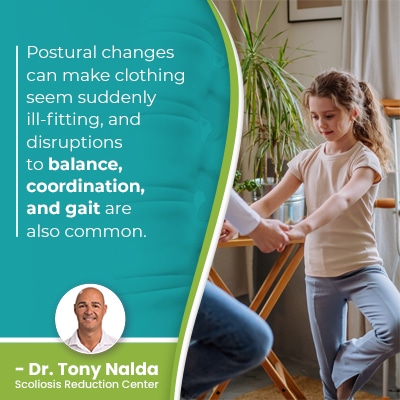 Postural changes can make clothing seem suddenly ill-fitting, and disruptions to balance, coordination, and gait are also common.
Postural changes can make clothing seem suddenly ill-fitting, and disruptions to balance, coordination, and gait are also common.
Symptoms of idiopathic scoliosis in children are centered around postural changes, and in adult patients, it's pain.
Pain and Idiopathic Scoliosis
A growing spine is undergoing a constant lengthening motion that counteracts the compressive force of an unnatural spinal curve, and once the spine stops growing, it's vulnerable to compression.
Compression is uneven pressure and is the main cause of scoliosis pain.
Compression of the spine and its surrounding muscles and nerves can cause muscle pain, back pain, and pain that radiates into the extremities due to nerve compression.
So while pain is the main symptom of scoliosis that brings adults in for assessment, diagnosis, and treatment, it's not considered a common symptom of childhood scoliosis.
While there are never treatment guarantees, early detection and intervention is associated with treatment success.
Idiopathic Scoliosis Conservative Treatment Options
Scoliosis ranges in severity from mild scoliosis to moderate scoliosis, severe and very severe scoliosis.
While scoliosis surgery is a treatment option, this is a type of spinal fusion that can be risky and invasive, and the reality is that many cases of scoliosis don't need spinal fusion surgery.
An unnatural curvature of the spine needs to be addressed proactively because curve progression makes the condition more complex to treat.
Curve progression means the size of the unnatural spinal curve is increasing, as are the condition's effects.
Conservative treatment is proactive and integrative; it's started as close to the time of diagnosis as possible and combines the power of multiple forms of treatment for the best potential results.
Here at the Scoliosis Reduction Center®, I combine a number of scoliosis-specific treatment disciplines so conditions can be impacted on every level.
Chiropractic Care and Reducing the Abnormal Curvature of the Spine
Chiropractic care can involve a series of techniques and manual adjustments that work towards adjusting the position of the curve's most-tilted vertebral bodies; addressing areas where the spine is misaligned and improving its alignment means improving the structural abnormality within the spine.
Structural changes achieved through chiropractic care have to be supported and stabilized, and physical therapy and scoliosis exercises are important for improving the spine's surrounding muscle balance and strength.
Physical Therapy and the Power of Exercise
Physical therapy can also help address poor posture and improve body positioning.
There was a time when the place of exercise in scoliosis treatment was questioned, but we have since learned that it is a powerful tool for addressing scoliosis and leading a spine-friendly and scoliosis-friendly lifestyle.
Corrective Bracing
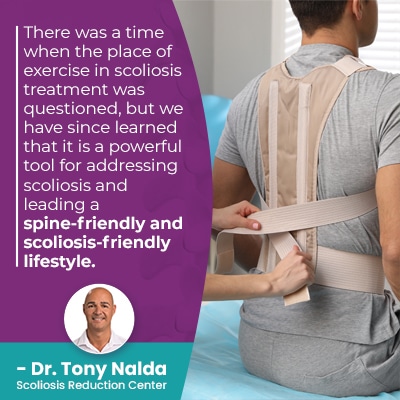 Corrective bracing is ideal for younger patients because growing spines are more malleable and responsive.
Corrective bracing is ideal for younger patients because growing spines are more malleable and responsive.
An ultra-corrective ScoliBrace can complement other facets of treatment and is an important treatment discipline for addressing childhood scoliosis, and in adult scoliosis, wearing a brace can help improve spinal stability and provide short-term pain relief.
Corrective bracing can help address idiopathic scoliosis by pushing the spine into a corrective position.
Rehabilitating the Spine
Rehabilitation can involve customized scoliosis exercises for further healing and stabilizing the spine. Continued chiropractic care and lifestyle guidance are additional facets of rehabilitating the spine.
As a progressive condition, treatment is more about managing an ongoing condition for the best quality of life.
While the complex nature of the condition is beyond the scope of a single treatment discipline, when an integrative approach combines the power of multiple types of treatment, they can work together to address scoliosis on every level.
Conclusion
Idiopathic scoliosis is the most common type of scoliosis, accounting for approximately 80 percent of known cases, and idiopathic means the cause of the condition's initial development is unknown.
When giving a diagnosis of idiopathic scoliosis, I'm met with a lot of questions, one of which involves causation.
I remind patients and their families that not knowing the cause of idiopathic scoliosis doesn't mean we don't know how to treat it effectively, and while there are no treatment guarantees, with early detection and intervention, there are fewer limits to what nonsurgical treatment can achieve.
An unnatural spinal curvature and scoliosis progression should always be taken seriously particularly when it comes to childhood scoliosis (congenital scoliosis, infantile scoliosis, infantile idiopathic scoliosis, early onset scoliosis, juvenile scoliosis, and adolescent scoliosis).
A spinal deformity can affect the cervical spine, thoracic spine, or the lumbar spine, and while spine surgery still has a place in the treatment of severe scoliosis and atypical cases, spinal surgery is invasive and risky, and surgical treatment isn't always necessary.
Scoliosis progresses at different rates, and spinal deformities that are triggered by growth have to be treated proactively; a child's spine will become increasingly rigid with progressive scoliosis, making it more complex to treat.
With current estimates at close to seven million people living with scoliosis in the United States alone, scoliosis screening and early diagnosis are invaluable.
A scoliosis curve can be highly responsive, and the earlier treatment is started, the better.
Dr. Tony Nalda
DOCTOR OF CHIROPRACTIC
After receiving an undergraduate degree in psychology and his Doctorate of Chiropractic from Life University, Dr. Nalda settled in Celebration, Florida and proceeded to build one of Central Florida’s most successful chiropractic clinics.
His experience with patients suffering from scoliosis, and the confusion and frustration they faced, led him to seek a specialty in scoliosis care. In 2006 he completed his Intensive Care Certification from CLEAR Institute, a leading scoliosis educational and certification center.
About Dr. Tony Nalda
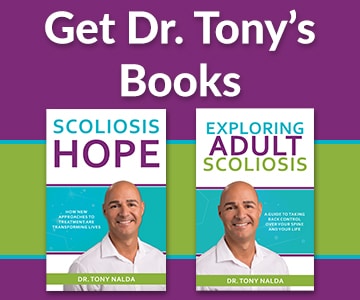 Ready to explore scoliosis treatment? Contact Us Now
Ready to explore scoliosis treatment? Contact Us Now